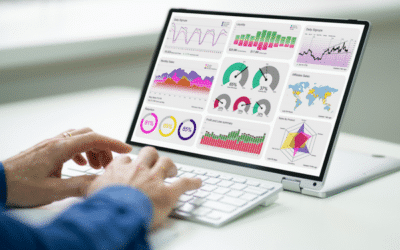Business Intelligence tools enable you to centralize, analyze and retrieve your company’s data, so that managers and executives can make decisions based on complete, accurate information.
Today’s software is high-performance, and the algorithms on which it is based enable safe and efficient information processing. However, we must never lose sight of the fact that the results obtained depend entirely on the input data, which is ofvital importance.
What data should be integrated into a BI tool?
Business Intelligence is used to monitor the company’s operations, and is therefore based on the company’s internal figures.
Consequently, the sources of the data integrated into your business intelligence tool are the company’s various departments: production, logistics, sales, quality, accounting, human resources, etc.
This not only provides a global view of processes, but also a detailed analysis of critical points.
However, it is important to distinguish between the source of these data and their origin.

Where does the data centralized by Business Intelligence software come from?
Every business has its own specific features, and every company has its own unique characteristics. However, all businesses rely on two types of information: internal and external.
Data from internal sources
This is all information that depends entirely on your organization, and whose reliability you can therefore control.
Examples of internally generated data include :
- Payroll costs
- Productivity
- The treasury
They are essential to the smooth running of your business and enable optimal operational management. Identification of bottlenecks in internal processes, areas for improvement in company profitability… All these points become easily detectable with the help of adapted and correctly implemented business intelligence software.
Data from external sources
Although they are integrated into your BI tool by a department within your company, they depend on partners outside your organization.
These data are, for example :
- Purchase prices
- Supply lead times
- Financial costs
These data are reliable, but offer no guarantee of future visibility. Tracking their evolution to detect trends is essential for your company’s long-term strategic management.
Once again, Business Intelligence software is a valuable aid, particularly when it comes to correlation research (data mining) or multi-dimensional analysis (OLAP cubes).
Introducing data into Business Intelligence
Business Intelligence software is capable of extracting, collecting and storing data, but it depends on how the data is fed into the system.

Manual data entry
Each employee fills in the information to which he or she has access. This approach has worked for decades, but it involves many risks:
- Data entry error: a €112.24 sale becomes a €11,240 transaction
- Loss of information: a product added to the order at the last minute and not removed from stock
- Interpretation problem: a quality department reports unresolved complaints as quality problems, and not all customer complaints.
Not only is manual data entry the cause of many inconsistencies and a problem for the reliability of information, it is also resource-intensive and costly for the company.
Automatic data input
As part of the digitization of company processes, it is now possible to automatically record all data relating to the organization’s operations. The advantages are many:
- Productivity gains
- Optimum use of resources
- Data reliability
In this way, Business Intelligence has direct access to the raw data handled by your company’s various departments, and the risk of error is drastically reduced. What’s more, this automation frees up time for department heads, who also have direct access to the information they need to carry out their work.
Example of automation :
Here’s an example to illustrate the benefits of automatically integrating internal data into your Business Intelligence tool.
In the logistics department, the day’s deliveries are based on a series of manual purchase orders sent by the sales department. Delivery notes are then issued by the store, which updates the inventory.
At the end of the day, the department manager checks that all deliveries have been made, and that all warehouse issues have been completed, before manually entering all data into the system.
The risk of lost coupons and quantity errors is high, while the store manager has to spend several hours performing an essential task with little added value.
Automating these processes would make it possible to :
- Ensure that no documents are lost thanks to a computerized listing
- Automatically update stocks when delivery notes are issued
- Give the store manager an up-to-date view of orders and stock.
All this data could be integrated into the BI tool in real time, and made accessible to other departments. In this way, the purchasing department knows whether it needs to place a new order with suppliers, the accounting department can invoice immediately, and the sales department can confirm to its customer that its product has been delivered.
How do you integrate data sources into your Business Intelligence tool?
Preparing and implementing Business Intelligence software is a decisive step in getting your new tool up and running smoothly. Properly implemented, they enable you to make the most of the opportunities offered by these solutions, by optimizing processes, boosting performance, and gaining a better overall view of your business thanks to up-to-date indicators.
The Altermès specialists can help you with your project, informing you about the solutions available and assisting you with their implementation.
Please do not hesitate to contact us for further information.
The Altermès teams, made up of both technical profiles and business experts, are available to help you implement and/or optimize your Business Intelligence project.
👆 Want to know what the best BI and Data visualization tools are, follow me!
👆 If you’d like to talk to us about a subject, a project or a problem, this is the place to do it!
👆 If you’d like to find out more about our data analysis support services, click here!











